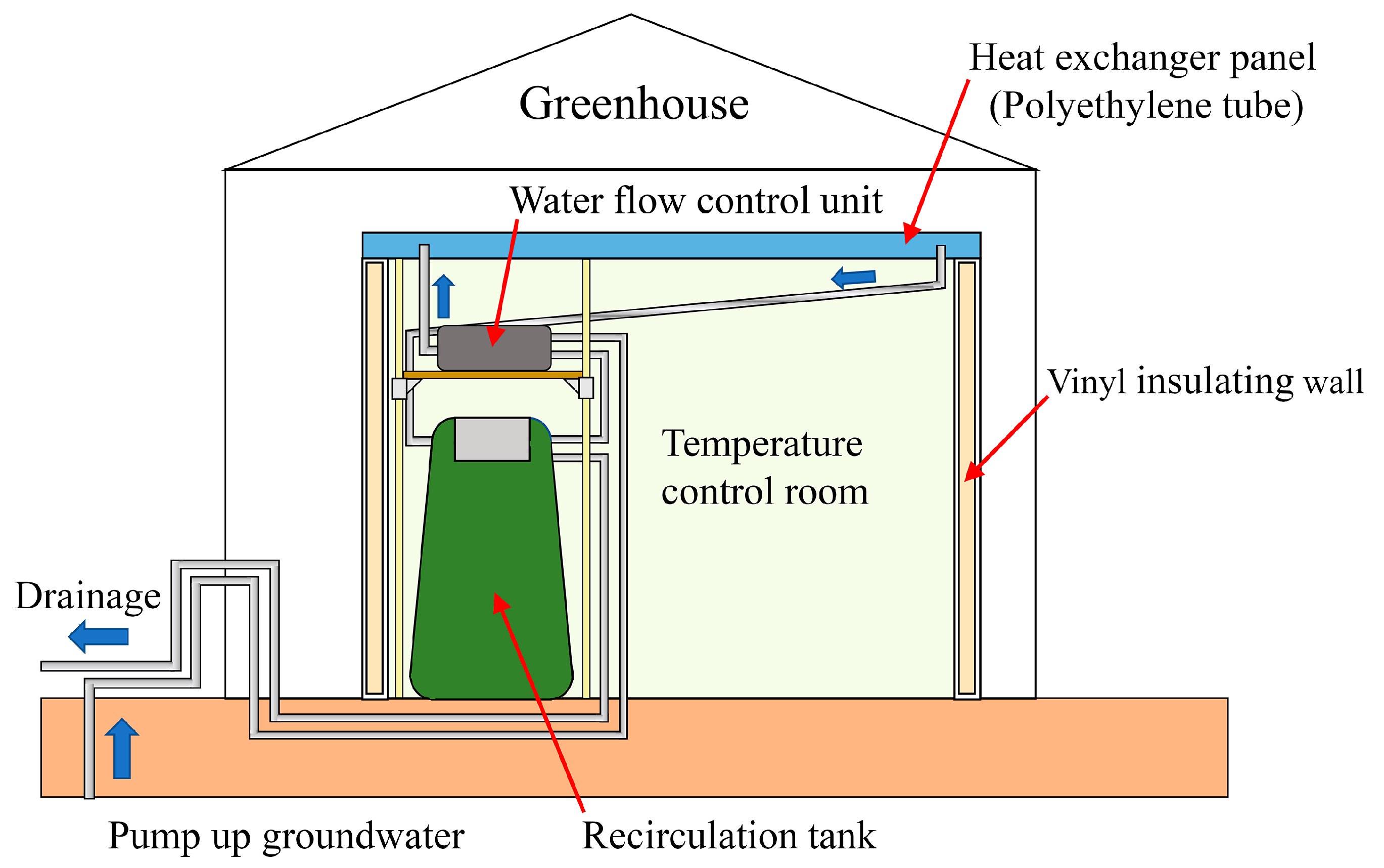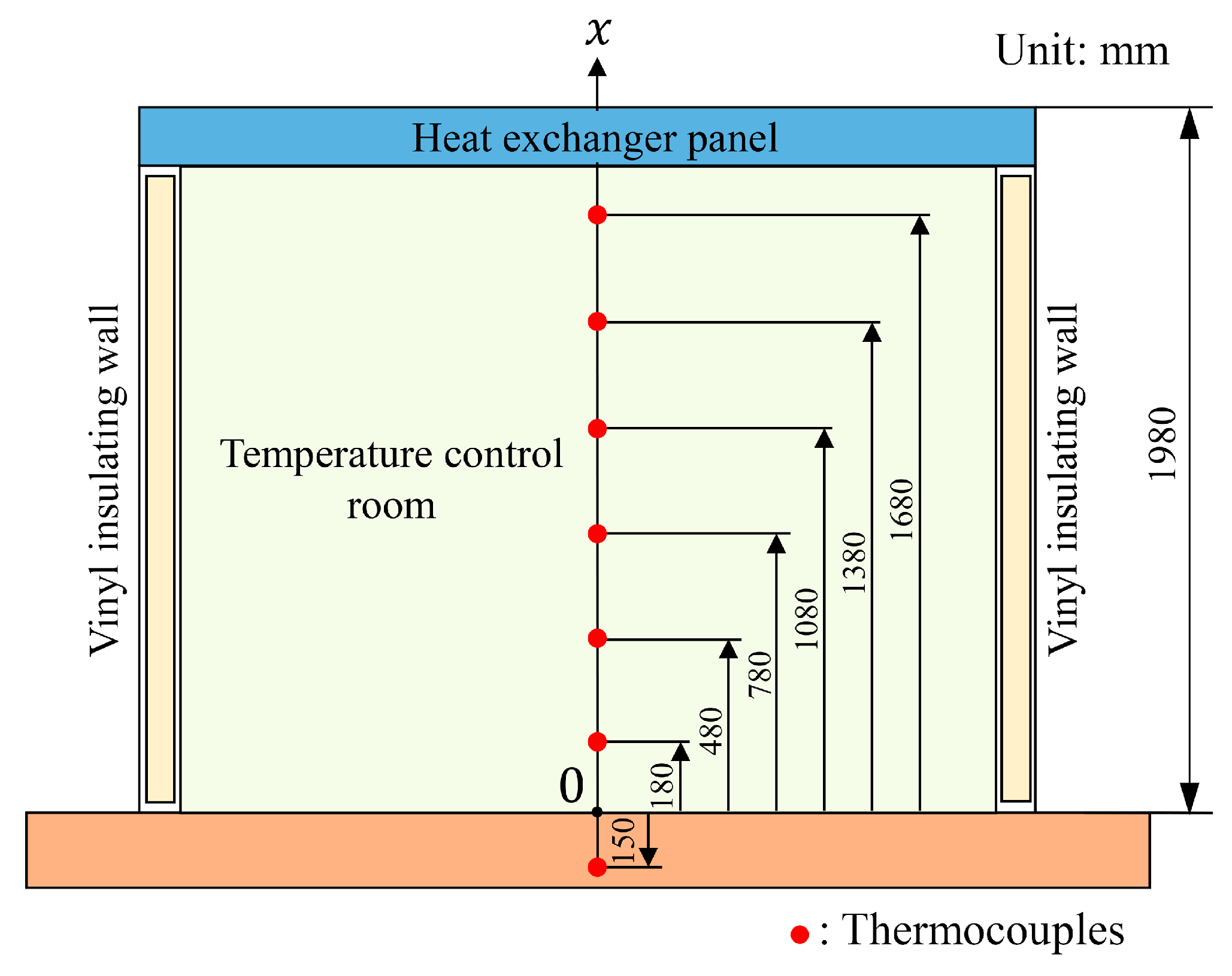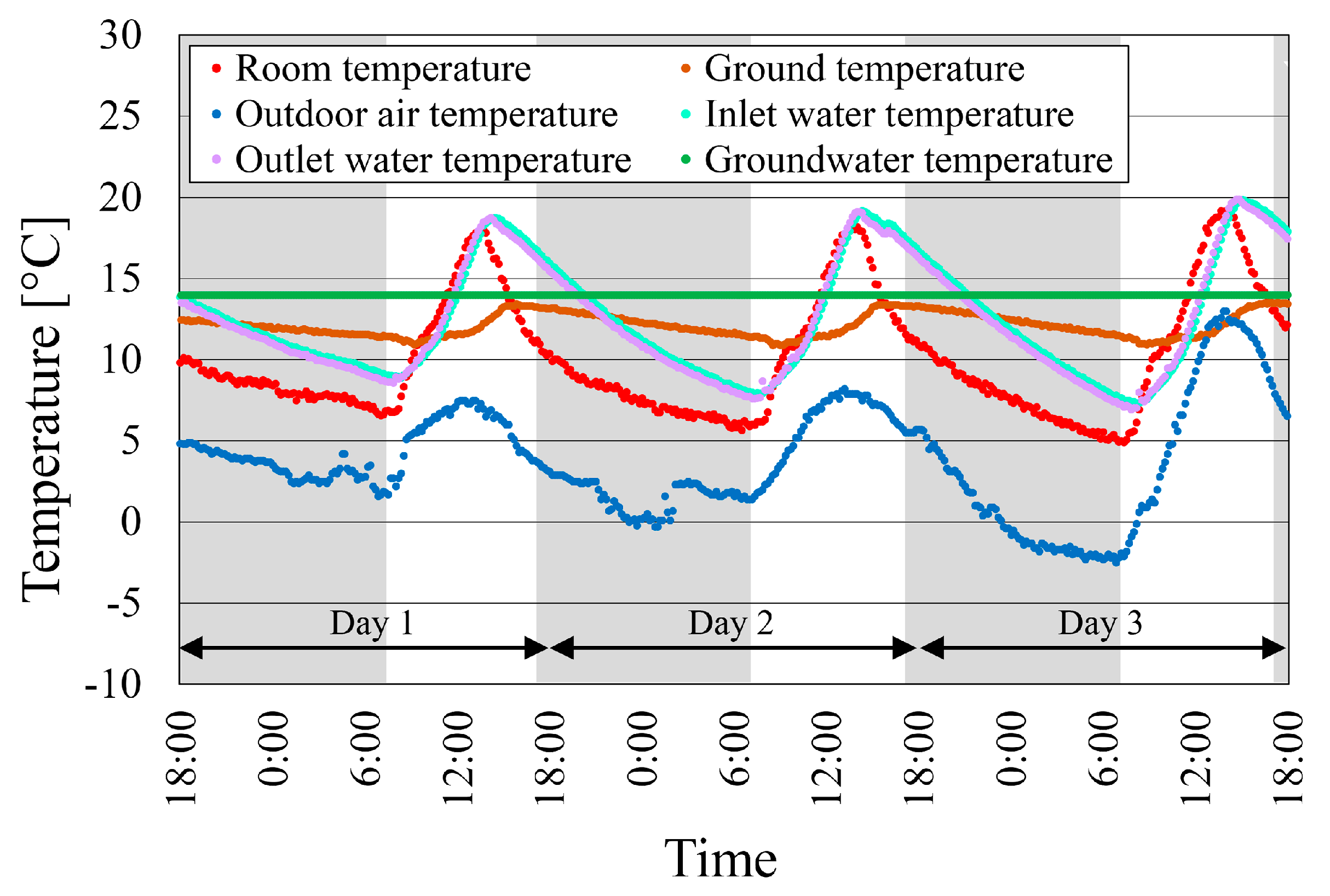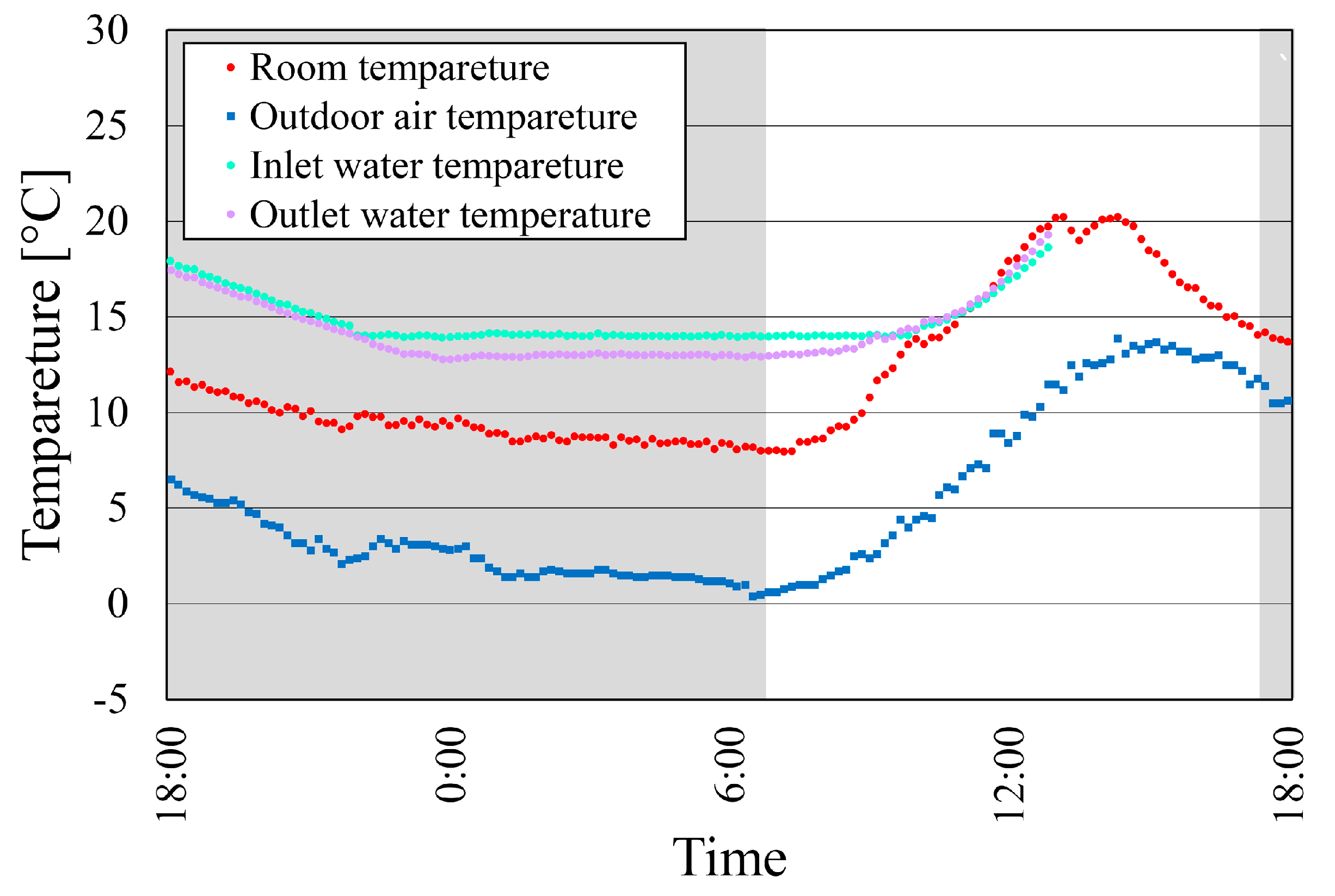An Investigation of the Heating Performance of a Groundwater-Based Air Conditioning System for an Agricultural Greenhouse
Abstract
1. Introduction
2. Experimental Setup and Methods
3. Uncertainty Analysis
- -
- Temperature measurement uncertainty: The uncertainty of the temperature measurement unit is ±0.5 °C (catalog value). For the uncertainty of the temperature measurement, the uncertainty of the thermocouple should also be taken into account, but since the uncertainty of the temperature measurement unit is much larger, ±0.5 °C is acceptable;
- -
- Uncertainty due to flow measurement: The uncertainty of the flowmeter is ±2%RS (Read Scale). For the water volume, a variable flow rate of 0.14 L/min, due to an adjustment at the ball valve, is considered as uncertainty.
4. Heating Performance Evaluation
4.1. Performance Evaluation with Recirculation Only
4.2. Improved Temperature Control by Adding Groundwater Flow
4.3. Improved Temperature Control by Adding Recirculation Tanks
5. Conclusions
Author Contributions
Funding
Data Availability Statement
Conflicts of Interest
References
- Runkle, E.; Both, A.J. Greenhouse Energy Conservation Strategies; Extension Bulletin; Michigan State University: East Lansing, MI, USA, 2012; pp. 1–16. [Google Scholar]
- Rorabaugh, P.A.; Jensen, M.H.; Giacomelli, G.G. Introduction to Controlled Environment Agriculture and Hydroponics; Controlled Environment Agriculture Center: Tucson, AZ, USA, 2002; pp. 1–130. [Google Scholar]
- Lijun, C.; Shangfeng, D.; Yaofeng, H.; Meihui, L. Linear quadric optimal control applied to the greenhouse temperature hierarchal system. IFAC-PapersOnLine 2018, 15, 712–717. [Google Scholar] [CrossRef]
- Ghoumari, M.Y.E.; Tantau, H.J.; Serrano, J. Non-linear constrained MPC: Real-time implementation of greenhouse air temperature control. Comput. Electron. Agric. 2005, 49, 345–356. [Google Scholar] [CrossRef]
- Monjezi, P.H.; Taki, M.; Mehdizadeh, S.A.; Rohani, A.; Ahamed, M.S. Prediction of Greenhouse Indoor Air Temperature Using Artificial Intelligence (AI) Combined with Sensitivity Analysis. Horticulturae 2023, 9, 853. [Google Scholar] [CrossRef]
- Hoseinzadeh, S.; Garcia, D.A. Ai-driven innovations in greenhouse agriculture: Reanalysis of sustainability and energy efficiency impacts. Energy Convers. Manag. X 2024, 24, 100701. [Google Scholar] [CrossRef]
- Azaza, M.; Echaieb, K.; Tadeo, F.; Fabrizao, E.; Lqbal, A.; Mami, A. Fuzzy decoupling control of greenhouse climate. Arbian J. Sci. Eng. 2015, 40, 2805–2812. [Google Scholar] [CrossRef]
- Xu, F.; Chen, J.; Zhang, L.; Zhan, H. Self-tuning fuzzy logic control of greenhouse temperature using real-coded generic algorithm. In Proceeding of IEEE 9th International Conference on Control, Automation, Robotics and Vision, Singapore, 5–8 December 2006. [Google Scholar]
- Shen, Y.; Wei, R.; Xu, L. Energy consumption prediction of a greenhouse and optimization of daily average temperature. Energies 2018, 11, 65. [Google Scholar] [CrossRef]
- Mostefaoui, Z.; Amara, S. Renewable energy analysis in the agriculture-greenhouse farms: A case study in the Mediterranean region (Sidi Bel Abbes, Algeria). Environ. Prog. Sustain. Energy 2018, 38, e13029. [Google Scholar] [CrossRef]
- Benli, H.; Durmuş, A. Performance analysis of a latent heat storage system with phase change material for new designed solar collectors in greenhouse heating. Solar Energy 2009, 83, 2109–2119. [Google Scholar] [CrossRef]
- Sethi, V.P.; Sharma, S.K. Thermal modeling of a greenhouse integrated to an aquifer coupled cavity flow heat exchanger system. Solar Energy 2007, 81, 723–741. [Google Scholar] [CrossRef]
- Ghosal, M.K.; Tiwari, G.N.; Srivastava, N.S.L. Thermal modeling of a greenhouse with an integrated earth to air heat exchanger: An experimental validation. Energy Build. 2004, 36, 219–227. [Google Scholar] [CrossRef]
- Takeda, T.; Okazawa, R. Study on energy saving effect of ground source heat pump applied as greenhouse air conditioning system. In Proceeding of the International Conference on Power Engineering-2019, Kunming, China, 21–25 October 2019. [Google Scholar]
- Takeda, T.; Higuchi, S. Evaluation of the effectiveness of direct expansion geothermal heat pumps in agricultural facilities. In Proceedings of the Yamanashi Industry-Academia-Government Collaborative Research Exchange Program, Yamanashi, Japan, 10 October 2019. (In Japanese). [Google Scholar]
- Nurettin Sezer, N.; Bayhan, S. Integrated solar-powered freeze desalination and water electrolysis system with energy recovery and storage for sustainable agriculture in desert environments. Desalination 2025, 595, 118321. [Google Scholar] [CrossRef]
- Ishtiaque, M.M.-U.; Saha, P.; Sutradhar, A.; Galib, M.; Hannan, M.A. A sustainable approach to improve the efficiency of earth pipe cooling system. Int. J. Sustain. Eng. 2020, 13, 387–397. [Google Scholar] [CrossRef]
- Toriyama, K.; Kawai, M.; Kado, T.; Funatani, S. A study of temperature control system by using groundwater in agricultural greenhouse. In Proceeding of the 49th the Japan Joint Conference on Air-Conditioning and Refrigeration, Tokyo, Japan, 15–17 April 2015. (In Japanese). [Google Scholar]
- Toriyama, K.; Funatani, S.; Kobayashi, T. Flow Stabilizing Device in Flow Path, Plant Cultivation House Including the Same, and Flow Stabilizing Method in Flow Path. JP Patent JP6748956B2, 13 August 2020. (In Japanese). [Google Scholar]
- Attar, I.; Naili, N.; Khalifa, N.; Hazami, M.; Lazaar, M.; Farhat, A. Experimental study of an air conditioning system to control a greenhouse microclimate. Energy Convers. Manag. 2014, 79, 543–553. [Google Scholar] [CrossRef]








Disclaimer/Publisher’s Note: The statements, opinions and data contained in all publications are solely those of the individual author(s) and contributor(s) and not of MDPI and/or the editor(s). MDPI and/or the editor(s) disclaim responsibility for any injury to people or property resulting from any ideas, methods, instructions or products referred to in the content. |
© 2025 by the authors. Licensee MDPI, Basel, Switzerland. This article is an open access article distributed under the terms and conditions of the Creative Commons Attribution (CC BY) license (https://creativecommons.org/licenses/by/4.0/).
Share and Cite
Toriyama, K.; Wakishima, K.; Kuranuki, I.; Tada, S.; Funatani, S. An Investigation of the Heating Performance of a Groundwater-Based Air Conditioning System for an Agricultural Greenhouse. Processes 2025, 13, 778. https://doi.org/10.3390/pr13030778
Toriyama K, Wakishima K, Kuranuki I, Tada S, Funatani S. An Investigation of the Heating Performance of a Groundwater-Based Air Conditioning System for an Agricultural Greenhouse. Processes. 2025; 13(3):778. https://doi.org/10.3390/pr13030778
Chicago/Turabian StyleToriyama, Koji, Kyosuke Wakishima, Ichiei Kuranuki, Shigeru Tada, and Shumpei Funatani. 2025. "An Investigation of the Heating Performance of a Groundwater-Based Air Conditioning System for an Agricultural Greenhouse" Processes 13, no. 3: 778. https://doi.org/10.3390/pr13030778
APA StyleToriyama, K., Wakishima, K., Kuranuki, I., Tada, S., & Funatani, S. (2025). An Investigation of the Heating Performance of a Groundwater-Based Air Conditioning System for an Agricultural Greenhouse. Processes, 13(3), 778. https://doi.org/10.3390/pr13030778








